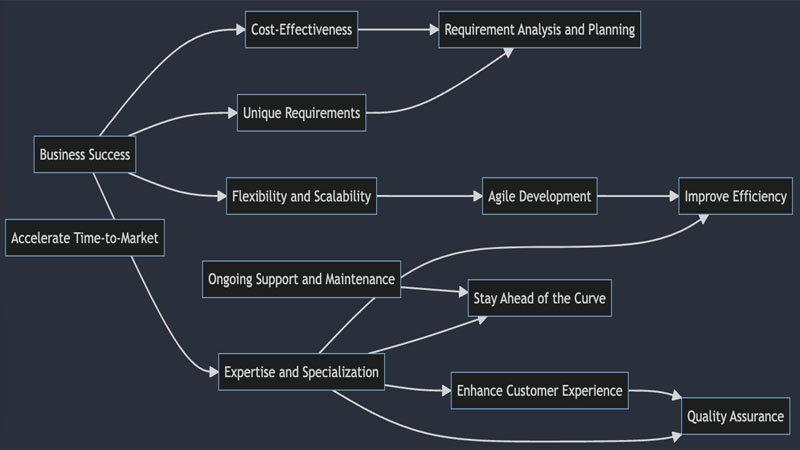In today’s digital-centric world, where smartphones have become ubiquitous, businesses are increasingly recognising the pivotal role of mobile app development in their growth strategies. The importance of mobile app development cannot be overstated. As it offers many benefits that empower businesses to thrive in the competitive landscape of the digital age.
In this article, we delve into the various facets of mobile app development and elucidate why it holds such paramount significance for businesses worldwide. Mobile apps have revolutionised business-customer interactions, enhancing accessibility, user experience, and brand loyalty, while also providing a competitive advantage and driving revenue. Embracing mobile app development is essential for businesses looking to thrive in today’s digital landscape.
Join us on this exploration as we uncover the myriad reasons why mobile app development has emerged as a cornerstone of success for businesses across industries.
Accessibility and Reach
In today’s fast-paced digital world, the significance of mobile app development cannot be overstated. Businesses across all industries recognise the immense value of having a mobile presence to cater to their customer’s evolving needs. Mobile app development is crucial for businesses because it enhances accessibility and reach, revolutionising how they connect with their target audience.
a. Convenient Access Anytime, Anywhere
Mobile apps serve as a gateway to seamless access to products or services, irrespective of time or location. Whether it’s purchasing goods, booking services, or accessing valuable information. Mobile apps empower users to engage with businesses effortlessly, right from the palm of their hands. This convenience factor not only enhances the user experience but also fosters loyalty and satisfaction.
Imagine a busy professional needing to make a last-minute purchase. A traveler seeking to book accommodations on the go faces a similar challenge. Mobile apps cater to these needs by providing instant access to relevant offerings, eliminating the constraints imposed by traditional brick-and-mortar establishments or desktop-bound websites. By leveraging the capabilities of mobile devices, businesses can stay connected with their audience 24/7. Offering unparalleled convenience and enhancing customer engagement for business.
b. Global Reach Beyond Physical Boundaries
Moreover, mobile apps transcend geographical barriers, enabling businesses to extend their reach to a global audience. Unlike physical storefronts limited by location, mobile apps have the potential to reach customers worldwide, breaking down the constraints of distance and geography. This global accessibility opens new avenues for expansion and growth, allowing businesses to tap into markets that were previously inaccessible.
Whether it’s a small local business aiming to expand its reach or a multinational corporation seeking to establish a foothold in emerging markets, mobile apps provide the platform for reaching diverse audiences with diverse needs and preferences. Localising content, language, and offerings enables businesses to customise their mobile apps for diverse regions, expanding their customer base and fostering business growth.
Enhanced User Experience
Mobile app development plays a pivotal role in delivering an exceptional user experience. As businesses strive to meet the evolving needs of their customers, the importance of mobile app development cannot be overstated. Let’s delve into how mobile apps offer a personalised and seamless user experience, driving engagement and satisfaction.
Personalisation is at the heart of modern mobile app development. Unlike traditional websites, mobile apps can tailor content and experiences based on user preferences, behaviours, and past interactions. By leveraging data analytics and user insights, businesses can deliver personalised recommendations, content, and offers, enhancing user satisfaction and loyalty.
Push notifications are another powerful tool for engaging users and driving interaction. With mobile apps, businesses can send timely and relevant notifications to users, keeping them informed about updates, promotions, and important events. Whether it’s a flash sale, a new product launch, or a personalised offer, push notifications enable businesses to stay connected with their audience and drive conversions.
User-friendly interfaces are essential for creating a seamless and enjoyable user experience. Mobile apps are designed with intuitive interfaces that prioritise ease of navigation and accessibility. From simple gestures to visually appealing layouts, every aspect of the user interface is carefully crafted to enhance usability and engagement. By providing a frictionless experience, mobile apps encourage users to explore content, make purchases, and interact with the brand.

Building Brand Loyalty
Building brand loyalty is essential for businesses striving to thrive in competitive markets. One powerful tool that has emerged as a game-changer in this pursuit is mobile app development. Let’s delve into how mobile apps help in fostering stronger connections with customers and why they’re crucial for building brand loyalty.
a. Enhanced Engagement and Personalisation
Mobile apps provide businesses with a direct channel to engage with their customers. Unlike other forms of communication, such as emails or social media, apps offer a personalised and uninterrupted experience. By sending targeted push notifications, businesses can keep users informed about new products, exclusive offers, or upcoming events, thereby maintaining their interest and engagement.
b. Loyalty Programs and Exclusive Offers
One of the most effective strategies for building brand loyalty is through loyalty programs and exclusive offers. Mobile apps serve as the perfect platform to implement such initiatives. Businesses can reward customers for their loyalty by offering points for every purchase made through the app or providing access to exclusive discounts and promotions. This not only incentivises repeat purchases but also makes customers feel valued and appreciated, strengthening their bond with the brand.
c. In-App Rewards and Gamification
Another way mobile apps foster brand loyalty is through in-app rewards and gamification features. By integrating gamified elements such as challenges, achievements, and rewards, businesses can make the user experience more enjoyable and interactive. Users are motivated to engage with the app regularly in pursuit of rewards, thereby forming a habit and establishing a deeper connection with the brand.
d. Seamless Customer Experience
Mobile apps offer a seamless and convenient shopping experience, allowing customers to browse products, make purchases, and track orders with just a few taps on their smartphones. By streamlining the purchasing process and eliminating friction points, businesses can enhance customer satisfaction and loyalty. A smooth and intuitive app interface leaves a positive impression on users, encouraging them to return to the app for future purchases.
Competitive Advantage
One of the most effective ways to stay ahead in this competitive landscape is by investing in innovative mobile app development. Let’s delve into why having a unique and cutting-edge mobile app can give businesses a significant competitive advantage.
a. Embracing Innovation
Stagnation is the enemy of progress in the digital age. To meet evolving customer expectations and market trends, businesses must continuously innovate. Mobile app development offers a prime opportunity for innovation by enabling companies to introduce new features, functionalities, and experiences that set them apart from the competition.
b. Enhanced User Engagement
Innovative mobile apps have the power to captivate users and keep them coming back for more. Businesses can set themselves apart from competitors by offering an immersive experience through intuitive interfaces, seamless navigation, and engaging features. This not only fosters customer loyalty but also ensures a distinct edge in the market.
c. Personalisation and Customisation
One size does not fit all in today’s consumer-centric market. Businesses that leverage mobile app development to offer personalised experiences tailored to individual user preferences can gain a significant competitive edge. By analysing user data and behaviour, companies can deliver targeted content, recommendations, and promotions, making their app indispensable to users.
d. Staying Ahead of the Curve
Innovation is not just about keeping up with the competition; it’s about staying one step ahead. By proactively anticipating customer needs and industry trends, businesses can develop mobile apps that offer features and functionalities that competitors have yet to introduce. This foresight positions companies as leaders in their respective markets, attracting new customers and retaining existing ones.
e. Adaptability and Scalability
The digital landscape is constantly evolving, and businesses must be agile enough to adapt to change. Mobile app development allows companies to quickly iterate and update their apps in response to market shifts and emerging technologies. This agility enables businesses to stay relevant and maintain their competitive edge over time.

Data-driven Insights
One invaluable asset that mobile app development brings to the table is the wealth of data it generates. Let’s explore how data-driven insights, enabled by mobile app development, significantly contribute to the overall importance of mobile apps in today’s business landscape.
a. Value of Data-driven Insights
Data collected through mobile apps provides businesses with invaluable insights into user behaviour, preferences, and interactions. This data serves as a goldmine of information, enabling businesses to make strategic decisions backed by concrete evidence rather than assumptions or guesswork. Mobile app data provides invaluable insights into user behaviour, guiding strategic decisions across business operations by revealing navigation patterns, feature preferences, and purchasing trends. Harnessing this comprehensive view empowers businesses to optimise their strategies and enhance user experiences effectively.
b. Understanding User Behavior and Preferences
Analytics tools integrated into mobile apps play a pivotal role in deciphering user behaviour and preferences. These tools track a myriad of metrics, including app usage patterns, session duration, popular features, demographic information, and much more. By analysing this data, businesses can gain deep insights into who their users are, how they interact with the app, and what motivates their actions. This understanding allows businesses to tailor their offerings and marketing strategies to better resonate with their target audience. Thus, ultimately driving engagement, retention, and revenue.
Revenue Generation
Nowadays, mobile app development has emerged as not only a necessity but also a lucrative avenue for revenue generation. By harnessing the power of mobile technology, businesses can unlock new streams of income and enhance their bottom line. Let’s talk about various monetisation strategies for mobile apps and explore how they underscore the importance of mobile app development.
a. Monetisation Strategies
Mobile apps offer a plethora of monetisation opportunities, allowing businesses to capitalise on their digital presence. Here are some effective strategies:
In-App Purchases: Offering users the option to purchase premium features, virtual goods, or additional content within the app can significantly boost revenue. This strategy is particularly effective for gaming apps, where users are willing to pay for enhanced gaming experiences.
Subscriptions: Subscription-based models provide a steady stream of revenue by offering users access to exclusive content or services for a recurring fee. Apps offering premium content, streaming services, or digital publications often adopt this model to monetise their offerings.
Advertising: Integrating advertisements within the app interface is a common yet profitable monetisation strategy. Businesses can earn revenue through various ad formats, including display ads, video ads, and native advertising, by partnering with ad networks or directly engaging advertisers.
b. Success Stories
Countless businesses have reaped the rewards of mobile app development by implementing successful monetisation strategies. Here are a few notable success stories:
Spotify: The music streaming giant revolutionised the music industry with its mobile app, offering users access to millions of songs through a freemium model supported by ads or premium subscriptions. Today, Spotify boasts millions of paying subscribers worldwide, driving substantial revenue growth.
Candy Crush Saga: This wildly popular mobile game generated massive revenue through in-app purchases of boosters, extra lives, and other virtual items. Its addictive gameplay mechanics and clever monetisation strategy catapulted it to the top of the app store charts and made it a household name.
YouTube: With its mobile app serving as a gateway to an endless stream of video content, YouTube leverages advertising as its primary revenue stream. Through targeted ads and sponsorships, YouTube generates billions in annual revenue, making it one of the most profitable apps in the world.

Conclusion
In conclusion, the significance of mobile app development for businesses cannot be overstated. Throughout this article, we’ve talked about the multifaceted benefits that mobile apps bring to the table in today’s digital era.
Firstly, we’ve explored how mobile apps enhance accessibility and reach, allowing businesses to connect with their audience anytime, anywhere, thereby expanding their global footprint. Additionally, the emphasis on providing an enhanced user experience through personalised interactions and intuitive interfaces fosters stronger relationships with customers, leading to increased loyalty and engagement.
Moreover, mobile apps provide a competitive advantage by enabling businesses to stay ahead of the curve, offering innovative solutions that meet evolving consumer needs. The insights gained from data analytics further empower businesses to make informed decisions and optimise their strategies for success.
Crucially, mobile app development serves as a potent avenue for revenue generation, with various monetisation strategies available to capitalise on the app’s potential.
Investing in mobile app development is not just about staying relevant. It’s about thriving in the dynamic digital landscape of today. To embark on this transformative journey and unlock the full potential of mobile app development for your business, reach out to Upscalix. Our team of experts is dedicated to crafting tailored solutions that align with your goals and propel your business towards success.
Don’t let the opportunity slip away. Contact Upscalix today and take the first step towards harnessing the power of mobile app development to drive your business forward.




































